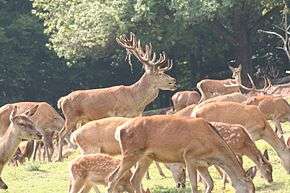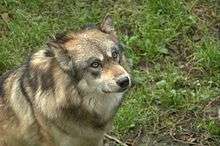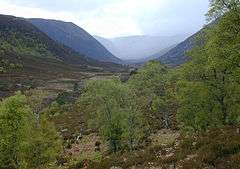Alladale Wilderness Reserve
| Alladale Wilderness Reserve | |
|---|---|
|
Glen Alladale | |
 Alladale Wilderness Reserve
| |
| OS grid | NH439897 |
| Coordinates | 57°52′11″N 4°38′00″W / 57.8697°N 4.6333°WCoordinates: 57°52′11″N 4°38′00″W / 57.8697°N 4.6333°W |
Alladale Wilderness Reserve is a privately owned estate in the Caledonian Forest in north Scotland. It is being managed so as to restore it to its natural state by increasing the tree cover of the valley, reintroducing native animals which are no longer found in Britain and encouraging biodiversity. Alladale Wilderness Reserve is currently the United Kingdom's largest wilderness engineering and rewilding area.
Environmental degradation and biodiversity losses in the British Isles
7,000 years ago, Britain was heavily forested. It would have been populated with wolves, bears, lynx, elk and a myriad of other large animals . But humans began to cut down a lot of the native forest, to make room for farmland. Almost all the large mammals had been forced into extinction by various means. Wolves were the last to go, becoming extinct in Scotland and Ireland in the 17th and 18th centuries respectively. Britain 7,000 years ago probably would have looked more like the untamed wilderness of Alaska, than the criss-cross of farmland seen today. The remotest highlands of Scotland prove to be the best candidates for rewilding in Britain.
Background
The Alladale estate was bought by English multimillionaire Paul Lister in 2003. The idea of a wilderness reserve was inspired by visits to South Africa's ever popular game reserves. The idea was to create an area of outstanding natural beauty, where animals previously extinct in Britain could be reintroduced. Letting nature return itself to an early Holocene setting by bringing in the right animals. This idea has been proven in South Africa, when over-grazed down graded farmland, was returned to its natural setting.
Arguably the most important aspect of the reserve, are the predators. As deer are already common in the park, they over graze the land, and trample any saplings (impeding another important aspect, the regeneration of the rare Caledonian forest). This (in theory) should be a more effective way of balancing the deer population, than culling, which so far has poor results. Another positive aspect of reintroducing large predators, is the increase in tourism (see Yellowstone National Park).
Wilderness reserve
The reserve is part of Glen Alladale, a broad glacial valley surrounded by 2,300-foot (700 m) mountains in a remote area near Ardgay in Sutherland. The Alladale estate of 23,000 acres (9,300 ha) was purchased in 2003 by Paul Lister, an English philanthropist, who hopes to recreate a natural wooded landscape and reintroduce native animals including predators such as the wolf and bear. The natural flora of the area consists of Scots pine, oak, aspen, birch, rowan, holly, willow and juniper, but much of the tree cover has been lost and low heathers, grasses and sedges now predominate. In 2014, about 800,000 saplings of these native trees have been planted. A feasibility study to investigate the potential affects of a controlled release of wolves and bears into the area is planned for 2014.[1]
The estate is an access route to the hill known as Càrn Ban, which is a Corbett in the Seana Bhràigh mountain range.[2]
Fauna
Wild animals found living in the reserve include red deer, roe deer, otter, red fox, mountain hare, badger, pine marten and Britain's most threatened mammal, the water vole. Brown trout and salmon are found in the rivers and streams. The moors are clad in ling and bell heather and are home to black grouse, red grouse and ptarmigan. Other large birds found in the reserve include the golden eagle, white-tailed eagle, osprey, buzzard, peregrine falcon, merlin, kestrel and raven.[3]
Red deer are the most common animal on the reserve. Their grazing has thwarted many previous attempts to restore the Caledonian forest. Deer stalking has proved effective at controlling their numbers. Wolves and lynx, may however prove a cheaper, easier, better, and more natural alternative to the deer problem. It is probably the deprivation of natural predators that drove deer numbers over the edge.

The European Nature Trust (TENT), is a charitable organisation founded by Paul Lister which focuses on the protection of threatened wilderness area. It has provided funds for the planting of native trees in the Kyle of Sutherland catchment area. This includes over 800,000 trees which had been planted by the end of 2014 on the Alladale Wilderness Reserve. TENT considers that forest restoration is important "for many reasons, including supporting some of the UK’s rarest species, helping to reduce pollution, generate oxygen, enrich the biodiversity of river tributaries, improving spawning and feeding grounds for native fish, providing natural barriers from flooding and filters for clean water." Another TENT project at the reserve involves planting trees with edible fruits to provide food for wildlife. These include wild apple, hazel, hawthorn and sessile oak.[4]
Criticism
Ramblers and hillwalkers are concerned that the fence will prevent access to grounds within the reserve. Enclosure could contravene principles of open access enshrined in the Land Reform (Scotland) Act 2003, and while Ramblers support reintroductions, they see charging for access to fenced enclosures as a way for owners of large estates to subvert the Act.[5]
Animals for reintroduction
The following animals have been, or are being, considered for reintroduction:
Herbivores
- Horse - several highland ponies live on the reserve, as a proxy for the extinct tarpan.
- Bovine - Highland cattle can be found living wild, as a proxy for the extinct aurochs.
- Wild boar - can be found roaming around the woodland of the reserve.
Predators
- Wolf - it was intended for a pack of four wolves to be released, but plans have been postponed.
- Bear - an omnivorous animal, that can hibernate throughout the harsh winter.
- Lynx - necessary for controlling the numbers of the small roe deer.
- Wildcat - three wildcats are currently housed in an enclosure on the estate.

Visiting the reserve
There is a lodge accompanied by two cottages on the estate offering accommodation and various activities are available including hiking, deer stalking, clay pigeon shooting, angling, mountain biking and safaris using off-road vehicles. There is also a programme for groups of youngsters known as the "Alladale School's Challenge" in which they participate in adventurous activities and sleep in tents. This programme for local school children was set up by the Challenger Trust as an offshoot of the popular World Challenge series of programmes. Funding was originally shared with the National Lottery but with the expiration of that source the European Nature Trust (TENT) has continued to fund it in collaboration with Highland Birchwoods. TENT would welcome any contributions either to fund or develop the programme.[3]
The British adventurer and television presenter Bear Grylls has set up the Bear Grylls Survival Academy here. Participants learn such skills as self-sufficiency, trapping wild animals, fire lighting, building emergency shelters and unarmed combat.[6]
References
- ↑ Caroline Fraser (2010-09-16). "In Scotland's Search for Roots, A Push to Restore Wild Lands". Yale Environment 360. Retrieved 2013-01-31.
- ↑ "Carn Ban (Walkhighlands)". Walkhighlands. Retrieved 2015-10-15.
- 1 2 "Alladale Wilderness Reserve". Retrieved 2013-01-31.
- ↑ Innes MacNeill, Alan Ross. "Scottish Forestry Restoration". European Nature Trust. Retrieved 2013-02-01.
- ↑ Weymouth, Adam (14 October 2015). "The place where wolves could soon return". BBC News. Retrieved 15 October 2015.
- ↑ Oliver Smith (2012-11-23). "Bear Grylls Survival Academy: roasted rat for dinner, anyone?". The Telegraph. Retrieved 2013-01-31.
